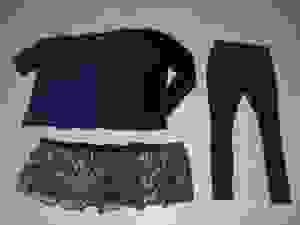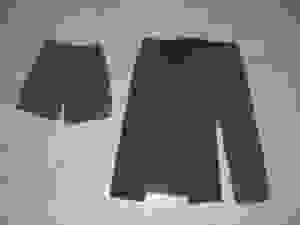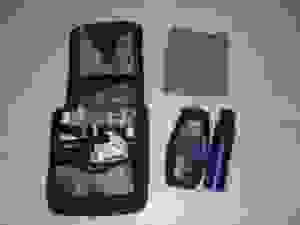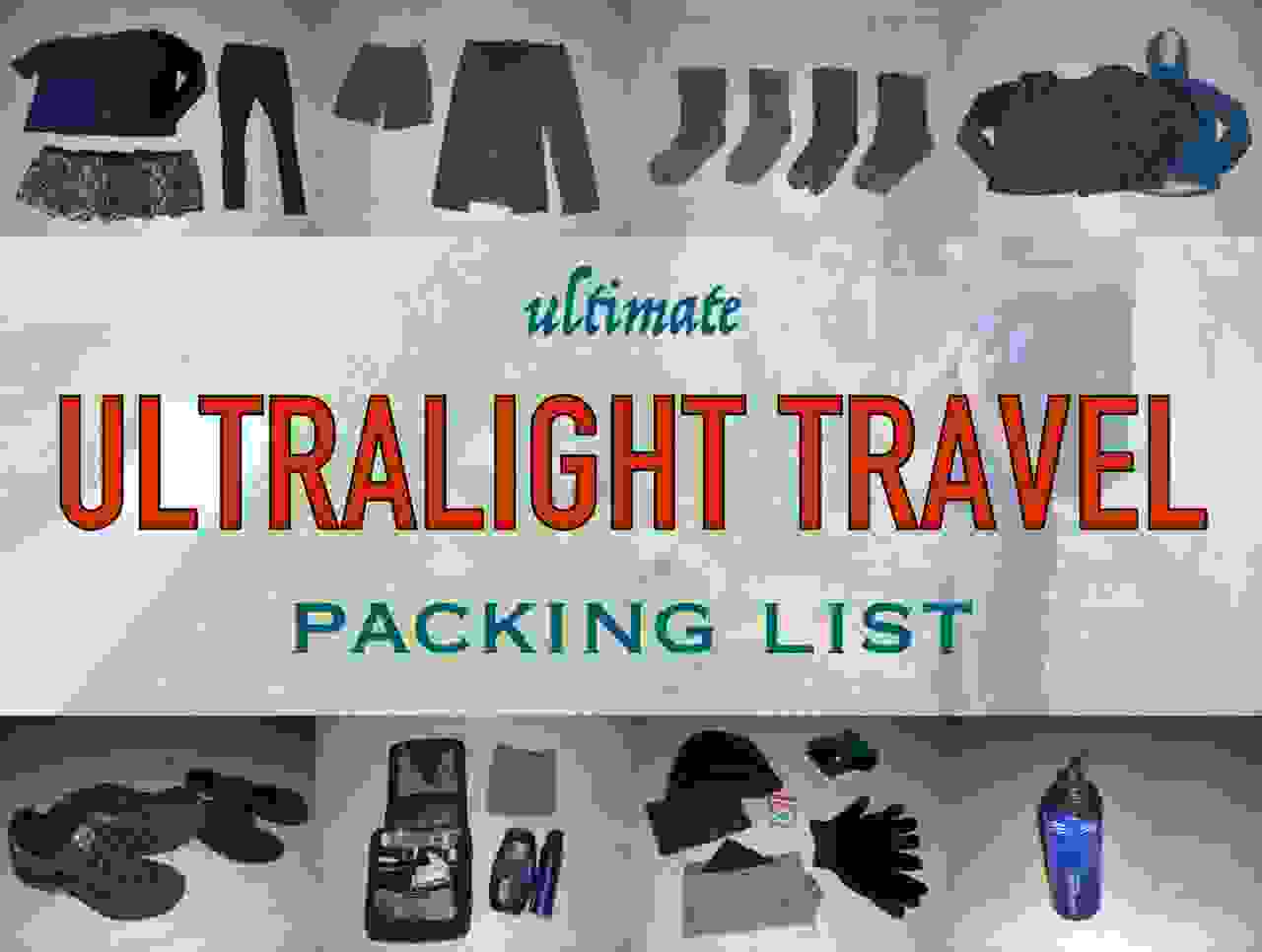Quite a few times I’ve heard backpackers complain about weight limits or maximum bag allowances on airlines. They haul 40-pound monstrosities that limit how comfortable they are, how fast they can run to catch the train, and how often they have to take a taxi because their bag is too heavy. They end up going a little slower, seeing a little less, and paying a little more. When they look at mine, they ask me where my “real” bag is.

I have traveled around the world on extended trips up to 9 months long with nothing but a 20 liter daypack, through summers, winters, jungles, cities, and everywhere else. It weighs less than fifteen pounds and fits in the overhead compartment on the plane.
I never have to worry about lost bags, check-in times, or waiting by the conveyor belt. I am the first person in line for customs, and stroll right in. I spend nothing on laundry or taxis. I am the first to finish packing every morning. I never spend more than five seconds trying to find something at the bottom of the bag. I wander around for hours with my pack, just because I can. I’ve gotten to the point that I really don’t know how to do it any other way, and my scrawny shoulders continue to thank me.
It’s a fun game I like to play with myself find to be an amusing intellectual challenge, but despite year after year of life on the road, I have met less than half a dozen people who do the same thing, and we are endlessly perplexed. Sadly, I have never been able to convince anyone to follow this plan. But I’ll give it one last try. It’s for your own good.
How to pack for ultralight travel

When thinking of things to pack for a trip, most people bring everything, “just in case,” and end up hauling a bag full of garbage they never use. Don’t do that.
Not a single person I’ve ever met has said “I wish I brought more.” You can spot the seasoned travelers simply by bag size. Instead of thinking about what to add, think about what you can cut. You know who else said that? Oh, just Bruce Lee is all.
Your limit should be the same as the airlines: 22” x 14” by 9”, or 45 liters (though it’s slightly smaller on certain no-frills European airlines). This will keep you in check (and allow you to reap the benefits of carry-on-only travel), since it’s all you can take, and it’s more than you need. If I got by with 20, you’ll get by with 45. Trust me. Just peruse this page and assume you’ll include twice as much.
1) Shopping for Ultralight Backpacks
For quite some time, the only options available were hiking packs, and while they’re quite good at what they do, a few companies have started designing what I consider travel-worthy backpacks (carry-on size, with a fully opening zippered panel, so you can pack it like a suitcase), which work great when you want to open everything up, instead of traditional top-loaders that need to be emptied completely to find something down at the bottom.
Since travel often requires lots of packing and unpacking, and somewhat less walking, it generally makes more sense to get a backpack optimized for travel, rather than hiking (unless you plan on hiking with it, of course). Check out a list of favorites here.
Wheeled suitcases aren’t a terrible idea, especially if you have back problems, but just remember they add weight and you’ll go crazy on cobblestones.
2) Ultralight Travel Clothing Basics
People constantly ask “how can you have enough in a daypack to travel for a year?” The thing is, you’re not packing for a year. No one is.
The secret is to pack the same gear, no matter how long the trip is. I bring 3 sets of clothes, wash whatever outfit I’m wearing when I take a shower, and hang it up to dry overnight. And you don’t even need to do manual laundry. If you bring a week’s worth of clothing and do laundry once a week, you can travel forever. It’s that simple.
You might get stuck with a sink wash sooner or later, which is why everything should (hopefully) be high-performance and versatile, wicking sweat and drying quickly, which cools you in summer, and warms you in winter. Try not to bring separate clothes for hiking, lounging, and clubbing. Just get clothes that look good and feel good. They should be suitable for any social situation. It’s a tall order, but it can be done.

Shirts: No cotton. It soaks up sweat and stays wet all day. Get polyester or merino wool t-shirts (read more about why merino is everyone’s favorite here), both of which wick sweat and dry quickly. Polyester should have an odor-control treatment if you plan on making any friends. Though I won’t judge you, it’s nice to have a fancy shirt for special occasions. I’d skip warmer thermal underwear. You can only wear them in winter, and you’ll probably bring t-shirts anyway, which dry faster after a sink wash. Leave the insulation to the outer layers, which you don’t need to wash as often.
Underwear: Let me tell you, “performance underwear” feels just as good as it sounds. Spoil yourself. Again, make sure it’s quick-drying, lightweight, odor-resistant, and comfy (take a look at a list of favorites here). In winter, long underwear works wonders. You’ll only need a single pair if you wear regular underwear underneath, so you won’t have to wash the heavier one as often.

Pants and shorts: Travel pants, ideally, should be lightweight, wrinkle-free, water-resistant, quick-drying, and look completely normal, despite having a few hidden pockets for hiding valuables. There are literally only a few that actually do this (which is ridiculous), but you can find a list of good travel pants here. Try to find pants that don’t look too silly, so you won’t have to bring extra pants for fancy fun times. If your pants fit, you can skip the belt, and for guys, quick-dry shorts double as swimwear. You can cut some corners here, as cotton pants won’t hold you back so much if you have an umbrella, don’t mind washing rarely, or have laundry facilities. Given the rarity of truly travel-worthy jeans, don’t feel bad bringing regular jeans.

Socks: I bought a pair of merino wool socks and threw out all my white cotton gym socks the same day. Seriously. Merino wool warms in winter, cools in summer, insulates even when damp, dries quickly, resists odor, and is soft and plush and wonderful. I’ve found nothing more comfortable for my feet. Most socks blend merino with polyester and other materials, and work well. I bring two ultralight pairs for summer use, and a warmer pair in winter, worn over the lighter ones so I don’t have to wash the heavy ones as often.
3) Outer layers
Layering is crucial. It’s better to take a few lighter pieces that you can layer together, rather than a heavy one you can only wear in Antarctica. You may have your own comfort system on this, but here’s what I recommend (or check out my winter travel gear list for details):

Inner warm layer: Find the lightest fleece or wool sweater you can find, comfortable when it’s cool, but not cold. I look for close fits to layer more easily, and a high, snug neck so I can skip the scarf.
Outer warm layer: For winter travel, goose down or synthetic insulation jackets (those big puffy ones) are one of the best ways you can shrink things down. Goose down is triple the warmth of fleece for the same weight, and packs down to half the size, meaning a medium-warmth jacket weighs 8 ounces. Synthetic insulation isn’t as warm or packable, but it dries faster and retains its insulating qualities when wet, whereas goose down does not, which is why I have thus far gone with synthetic. Since it is encased in a nylon shell, it works well as a windproof outer layer, while the fleece sweater on the inside will be comfortable against your skin.
Rain jackets: I don’t have much to say here, and umbrellas work well enough anyway. I just look for light weight, comfort, a hood that covers my face, and enough venting to keep me cool (take a look at some ultralight rain shells, some of which are half the weight of standard jackets). Don’t get something insulated that you can only wear in winter. Layer instead.
Wind jackets: Climbing up a windy mountain on a chilly day calls for something windproof that won’t overheat, and a wind shell is the only thing that fits the bill. I wouldn’t call it a necessity, but mine is about 3 ounces, and I wear it all the time.
4) Travel Shoes
I met a guy with separate hiking boots, running shoes, evening shoes, and sandals. Here’s an idea. Why not buy shoes that look good and feel good?

There’s not much reason to bring serious hiking boots, which are designed to support 50-pound packs, which you won’t have. A nice-looking, tough, comfortable shoe that fits properly and offers good support will be suitable for all occasions. Especially if they’re waterproof.
One pair of shoes, end of story (probably leather, described here). And one pair of flip-flops or sandals. Comfy but light.
Women’s fashion is less forgiving. If you have to bring a separate pair of evening shoes, just make them small. If all it’s got on top are straps that can lay flat, perfect. Only bring one pair. Anyone who calls you out on repeat clothing will be another scruffy backpacker who will be in no place to make comments.
5) Travel Accessories
Again, anything you stuff in here should add value, not just weight. So far I’ve avoided packing cubes, but they’re not a bad idea.

Toiletries: I travel with nothing but airplane-sized bottles (maximum 3.3 ounces, or 100 mL) so I can take them on the plane, and reuse them on each trip. When the bottles run out I buy a larger one, refilling the mini so I can throw the big one away sooner. This way I might have one or two big bottles at any one time, instead of my entire supply being oversized (though an all-in-one bar soap is great for solving this problem). Check out a comprehensive toiletries list for details.
Travel towel: This is another of the most significant ways you can cut size and weight, as huge cotton towels are big, heavy and dry slowly. Microfiber towels are light, small, super absorbent, and wring out 90% dry. You can even get by with a washcloth-sized micro towel which will fold up to the size of a napkin, though it’ll take some extra time to dry yourself off. Definitely get one of these. They’re cheap and enormously efficient (though I’ve recently discovered linen towels are even better).

Sleeping bags: This is another one of those “surely I must need this” items that people end up never using. 99% of people stay in hostels and never use their sleeping bag. If you’re worried about hostels that require you to rent sheets, I’ve traveled for 15 months and spent maybe $3 on them. It’s not worth the extra weight. If you want to be a little warmer, you can sleep in your long underwear, or you can get a bag liner, which is incredibly lightweight and small, and will keep you warm enough indoors. If you really need a sleeping bag, you can find some that are the size of a 1 liter water bottle and weigh 1 pound. But if you don’t plan on camping, forget it.
Daypack: I try to avoid bringing an extra bag, but now that we have ultralight options that fold up into their own pocket, I’d recommend it. You’ll do a daytrip or climb a mountain and you’ll want to bring a jacket, food, water, maps and whatever. I had one made by Sea to Summit that holds 20 liters, weighs 2.4 ounces, and fits inside a coffee mug.

Other extras: I’d recommend a money belt (unless your pants have security pockets), a deck of cards, a nice small camera (or smartphone), a journal, sunglasses, an outlet converter, hat, gloves, and two books (it’s hard to find a book right away once you finish), or an e-reader. Those are all the extras I ever use. Umbrellas aren’t a bad idea if you don’t want to spend $100 on a rain jacket. Just remember that if you want to add extras, think about how often you’ll use it, and if it’ll be worth it.
Budgeting for ultralight travel

Poor? So was I. Patrol eBay and watch for sales. Besides, you shouldn’t buy more than a minimum of gear. Three backpacking outfits shouldn’t be too expensive, and you might have a few running shirts already, and some warm clothes, and good shoes. Some of it you’ll wear back at home after the trip, especially the socks and underwear.
If you have to cut corners when packing for a trip, regular cotton pants and shorts will be fine, as long as you’re not washing too often and rainstorms don’t ruin your day. You can skip the rain jacket and bring an umbrella, and winter gear can be cut outside of winter. I wouldn’t cut the travel towel, since it’s less than $20 and will save you lots of space and weight, and quick-drying base layers are kind of a necessity for this to work, unless you’re doing machine washes once a week or so, in which case it’ll be fine.

You should now be a thoroughly converted ultralight, minimalist backpacking genius. Once you do this, it’s hard to go back. This method is forced upon all travelers on Rick Steves’ tours, many of whom claim it’s impossible ahead of time, but talk about how great it is after. This strategy has close to a 100% success rate. And whether you’re packing for Europe, or Asia, or India, summer or winter, it’s always the same.
Oh, and by the way, the photos displayed here represent absolutely everything I took on a 9 month trip (except the camera), from temperatures below freezing to body-temperature sunshine. Towards the end of the trip, someone asked if there was anything I would have added. I said no. Someone else asked if there was anything I would have removed. I said no. I was super proud of myself.
Eventually I added a few things: A packable daypack, an ultralight wind jacket, a collared shirt, and swapped the emergency blanket for a sleeping bag liner instead (which is still just optional anyway). Overall weight was almost the same, and these items can be extremely useful.
Hmm. Talking about all this makes me want to go shopping. I’ve been working on getting my year-round pack down to about 12 pounds…





Great post, thanks. I’m planning to take no more than a 30L pack with me for a 6 month trip from the foot of Argentina to Peru this coming January. I vowed never to overpack again having taken way, way too much stuff on my last backpacking adventure.
Its so hard finding nice looking clothes for guys though.. I know its shallow, but I want to still feel like me! That’s another topic though isn’t it.
Cheers!
To me, form is function. If 100% of my clothes look nice, I don’t have to carry an extra change of “nice” clothes. I don’t mean super fancy, but at least presentable. I wish the outdoorsy companies would figure this out.
Actually, it’s much easier to find nice looking clothes for guys than you’d think. The only problem is the price, but that’s often the case with clothing that isn’t meant for traveling or technical wear anyway.
There have been more and more companies cropping up, which makes me happy. I’ve discussed them over in this article. Love having them around.
Personally, I find with todays selection the whole situation has so much more to do with two things: perspective and a sense of style. If one was to compare what they would buy for “Every day clothing” for a certain degree of weather to something more technical made for hiking or traveling or what have you, the biggest difference is quality. Clothing always makes a statement, whether you mean it to or not. If you pick up the black raincoat from Marmot with taped seams and well made zippers it says something very different than if you pick up a raincoat from Zara or H and M that won’t last anywhere near half as long or function anywhere near as well.
I live in the Canadian rockies and was talking to someone at an outdoors/hiking store and he told me that at that store they jokingly refer to the Atom LT from Arc’teryx part of the Canmore Uniform. In black, that jacket would look fantastic in most 5 star restaurants.
I totally agree, I guess I had better start searching..
Thank you for the awesome and detailed post! This can be done, in just about any life situation. I am not a nomad, but a mother with children, and while my bag is in the 30L zone, I keep it light and comfortable. It is a challenge sometimes to not overpack with kids, but (this might sound silly) I repeat some mantras to myself to keep the extra pounds (and bags!) from sneaking in: “Don’t need it. Never did.” and “Experience life on a trip, don’t lug it around.” One of the biggest blocks to carry-on/lightweight travel I see in some people is the notion that one cannot look properly groomed/presentable with a minimal amount of stuff/gear/cosmetics/whatever. On the contrary! When I see people with carry-on bags and smiles on their faces, I just think, “Wow, he/she looks SMART.”
This is something I attempt (unsuccessfully) to tell people all the time. You don’t need eight different fancy outfits to look good. All you need is one. The other seven aren’t making you look good while they’re in the pack!
This is great! I literally googled “Is a 28 liter backpack enough for a 2 week backpacking trip?” and your post came up.
I lived in Kenya for 9 weeks (and worked in an office, requiring appropriate clothing) and backpacked around Kenya, Uganda, and Rwanda (varying temps) for another 4 all using a 55 liter pack. This coming May, I am going to be backpacking around the Dominican Republic for 2 1/2 weeks before a friend’s wedding. I have my eyes set on this 28L Northface Angstrom, but I’m still unsure if I can fit everything in it. I have the same system of washing my clothing each night in the shower, so clothing quantity will be low, esp since it will be hot, but I also intend to bring my small netbook with me. I almost think I just need to buy it and test packing it to see if I can fit everything in it.
But since the DR isn’t a big backpacking country, I don’t want to be inhibited by a huge backpack…I want to be able to take crowded public transit etc and not ENTIRELY stick out like a sore thumb!
I like to take all the gear I’m taking on a trip, and stack it in a tower. Doing this up against a corner of a room helps it stay upright, and you can get a rough estimate of how big a pack needs to be. Sometimes the liter measurements vary from on company to another, so it helps to get the dimensions too. Remember that a zippered opening like the one on that North Face will be a little harder to pack and unpack, so it helps to have empty space to make this easier.
Great review! What is model of the 20 liters backpack shown in the pictures?
Thanks!
It’s the Deuter DS 20. They don’t make it anymore. Which is stupid, because it was waterproof, and barely anyone makes waterproof backpacks, which is also stupid. It was oddly uncomfortable on me, though, so don’t feel too bad about missing out on it.
I put an OR 20L drybag inside my 19L MEC pack – everything inside stays dry, even in a monsoon. MEC now makes ultralight drybags, so if my OR ever fails, I’ll pick that up. This is a cheap solution – I can’t afford an Arcteryx waterproof pack.
Yeah, that’s the strategy for a lot of people. I just wish there were more waterproof pack options out there, or at least rainproof.
I was skeptical after reading your title with the world “ultralight”, “packing” and “list” in it as most other articles and lists I’ve read with those keywords are about 50 liters and up – they have no idea what “ultralight” or “minimal” is. With that said, its nice to see your list is indeed ultralight, welcome to the club.
I think “light” is airplane carry-on size or less, and “ultralight” is about as light as it gets while still having the potential to appear as though you are a normal human being.
So… what’s your windshirt recommendation?
I’ve been using a Patagonia Houdini for years, and I love it. It’s hooded, light, packable, and very simple, pretty much having no features at all. I was also lucky enough to find it in a pretty muted shade of dark blue, which makes it look nice and casual, rather than resembling high-tech outdoorsy gear. The version they sell nowadays is only slightly different, so it would probably work just as well. I generally prefer the hooded ones, because I’ll get caught in the rain sooner or later, and it’ll come in handy. It’s been a favorite of mine for a long time.
Nearly adequate, but could have used a couple more items. And, I couldn’t disagree more strongly about hiking boots!
On our recent trip to Andalucia I wished every day I had brought another pair of underwear, another shirt, another thermal shirt, and proper hiking boots! We never did more than about 10 miles in the mountains, but my high-end walking shoes were no match — stiff soles and good ankle support were what I needed but left sitting in my closet at home.
Thus my suggestion would be for a comfortable pair of walking shoes that can also double as evening shoes, plus a pair of hiking boots. Wear the boots on the plane and pack the shoes with socks, etc.
Well, serious hiking with a heavy pack requires some hiking boots, but I expect most backpackers go on short day hikes, rather than multiple overnighters requiring heavy gear. But I like to point out that most backpackers aren’t really going to be doing serious hiking, but they kind of assume they might need the heavy boots anyway, so I like to point out that they probably don’t.
I’ve hiked and backpacked in barefoot sandals instead of boots for years. 10-15 miles a day in the Olympics and Cascades with (usually a light daypack) and a 30 pound multi day pack (I’ve still got some old heavy gear). You have to build up your tolerance, but it’s doable. I had no foot/ ankle injuries after I switched to sandals but had sprained my ankles in boots before.
this is great inspiration, i totally agree with the wonders of ultralight backpacking. first of all because it just feels great to get rid of all that stuff you’d be supposed to look after and depend on!
problem is i mostly travel to ‘challenging’ regions (i.e. scandinavia), camping and hitchhiking on the way, which results into some 10 more kilos between tent, serious sleeping bed and mat, food, torch etc etc. i wish there was some way to keep it lighter, but i’m so afraid there ain’t!
Yeah, that’s a bit of a problem. Goose down sleeping bags certainly help reduce size and weight, but there’s only so much you can do if you need to bring camping equipment along with you. I rarely do that, though I certainly think it’s great for those who want to be a little outdoorsy on their adventures.
There is a way! Check out http://andrewskurka.com/ for the best tips on lightening your load when hiking with shelter and sleeping bag to ‘challenging regions’, while keeping the weight to well below 10lbs.
I’ve travelled to some of the harshest, windiest, wettest places (Iceland, Faroe Islands, Scotland), camping in a tent every day with my girlfriend. We used one 40L bag that I carried (base weight 6kg without food or water) and one 22L bag that she carried, weighing 4kg. We did serious long distance hikes, often hiking 45km per day for days, crossing treacherous glacial rivers, black sand deserts, and lava fields. But we also travelled by bus, jet and ferry, visiting and enjoying cities along the way without being or feeling dirty or stinky. In fact, when walking around the city with our packs, we looked like our normal selves, you know, people that walk around in a pair of running shoes, pants and jacket with a pack on their way to school.
When lightening the load drastically, you can ditch the boots and wear trail runners. My girlfriend has ankle problems, and stiff backpacking boots, heavy packs and no trekking poles only made it worse. Carry a set of trekking poles that can double to erect a tarp and netting. The poles should collapse so they can be stashed inside your pack to avoid looking like the tired and weary hiker-backpacker. Black Diamond Ultra-distance Z-poles are so small and light you wont even notice them. Also, research your destination, then pack for likelihoods, not what-if’s based on fears and ignorance. Test your gear in the conditions you expect, then do shakedown hikes and short-distance travelling to test your packing theory.
If you need the best tips on lightening the load when travelling with your shelter and sleeping bag on your back, search ultralight hiking, fast-packing, alpine climbing, and ‘fast and light’ to reveal the wealth of information on forums and blogs related to this mature and still growing interest. These resources can also be useful for people who don’t hike or climb, since it can put your travel plans and ideas into perspective, giving you focus.
Hi!
This is a great list! I’m a 18-year-old guy from Finland and I’m going interrailing this summer, for a month. I decided to go with my 22 liter backpack when I saw my friend’s 45 liter bp. I thought it was a bit too much, since we’ll be traveling in cities where everything is available if needed and the weather will probably be warm and sunny. I’m traveling without my parents for the first time and I’d like to ask if you have any tips on packing things for traveling around Europe? Or just general tips when traveling independently for the first time?
If you’re staying in hostels, I’d recommend staying in smaller ones. If you can find a hostel that has just a few bedrooms, with just one common room and only one table, then you’ll meet everyone when you sit down for breakfast every morning. Smaller hostels are much better places for meeting other solo travelers, whereas big hostels tend to have big groups of friends who mostly just want to get drunk with each other. Not all the time, but quite often. Sometimes they’re happy to include new people in their circle, but I just think it’s easier to meet new people in a smaller setting, which is how you’ll have the most fun traveling. It’s really the people that make it memorable.